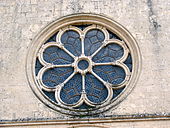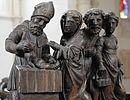Notre-Dame-de-l'Assomption (Montréal)
Notre-Dame-de-l'Assomption ( Assumption of Mary ) is a Romanesque collegiate church from the 12th century in Montréal in the French department of Yonne . The church is on the top of a hill above Montréal. It contains important choir stalls from the 16th century.
history
After the happy return from the Second Crusade , to which Bernhard von Clairvaux had called in Vézelay in 1146 , Anséric I , Lord of Montréal, began building the collegiate church of Montréal. The construction of the church was finished around 1170 by his son Anséric II . The associated canons' pen was abolished during the French Revolution .
In the middle of the 19th century, the famous architect Eugène Viollet-le-Duc was so impressed by the building that he called it a “real jewel of architecture” and the church was included in the list of Historic Monuments . In addition, he set up a foundation for the purpose of their restoration.
Church architecture
The semicircular portal with Arabic-inspired serrations is an example of the floral Romanesque style of Burgundy and extends over about a third of the facade.
The two doors attached to the central pillar still have their wrought iron hinges from the 11th century. The tympanum's sculptures and paintings were destroyed during the French Revolution. Only the almost blurred inscription remains from this period: The French Republic recognizes a Supreme Being and the immortality of the soul . It is remarkable that the cult of the "Supreme Being" introduced by Robespierre only ruled for barely a year. After that, the churches were reopened for Catholic worship.
The rose window above the portal is one of the oldest still in existence in France. The artistic stone laying is remarkable. The gallery above the facade stands on thin twin columns with bold beams (= girders). The side walls have sloping windows with four different crosses that sit lightly on the four gables.
At the time the church was built, there was - as it is today - no bell tower. Various attempts to build a tower failed. A tower was last built in the early 19th century, which Viollet-le-Duc had laid down when he was restoring the church.
Since the floor of the church is three feet below the current level of the ground, the entrance is via steps. The church was built in a single construction phase during the transition from Romanesque to Gothic in the second half of the 12th century and thus has a uniform architectural style.
On the smooth pillars you can recognize various marks (leaves, stars, etc.) that come from the stonemasons who built the church. The capitals are all designed differently: except for one on the left, they show flowers and leaves. This shows a crouching man: the popular motif of an Arab or Moors in a humiliating position during the time of the Crusades and the reconquest of Spain .
The square apse of the church closes with a stone bench, which forms the basis for six blind arcades . One of these arcades contains the lavabo , the basin for the priests to wash their hands during mass. Parts of the boltwork of the door to the sacristy go back to the 12th century.
The sculptures of the choir stalls
|
The paradise
Adam and Eve in Paradise: They are seduced by a serpent with a woman's head and eat the forbidden fruit. Adam already seems to recognize his mistake and grabs his throat with his hand as if he could not swallow the bite. |
Allegory of virtue and vice
Virtue in the form of a cleric holding a book, possibly the Bible. He defeats a repulsively ugly demon. This is an allegory of the victory of Catholic theology over heretics. |
|
Visitation of the Virgin Mary
The visitation according to ( Lk 1.39–45 EU ). Maria puts her hand on the pregnant Elisabeth's lap and feels the child moving in her lap. The landscape with the mill and castle is typical of the 16th century in Burgundy. |
Shepherds
Annunciation to the Shepherds of Bethlehem. |
|
The baptism of Jesus
As reported in the Gospel, John the Baptist appears amazed at the appearance of the Lamb of God . |
Allegory of Strength
David (or Samson) fights a lion ( 1 Sam 18.34-36 EU ). This is a traditional representation of the victory of good over evil. |
|
Josef's carpentry workshop
Josef in his carpenter's workshop in Nazareth and Maria, lovely and peaceful at a sewing job. An angel teaches the baby Jesus to walk by pushing him in a frame. This scene is typical of a craftsman's household in Burgundy in the 16th century. |
The Samaritans
Jesus and the Samaritan woman at Jacob's well according to John |
The figures on the stalls
Two lions
|
Adoration of the Magi
The three kings come to pay homage to the Christ Child. They symbolize the three races known at the time. Jesus, in his mother's arms, tries to take the gifts. The clothing corresponds to the costume of the 16th century. |
| The Presentation in the Temple |
Two people at the lectern
Two men at a single lectern. Perhaps this is the representation of the two wills. |
Two men drinking
|
See also
literature
- Père Arnaud Montoux: Colléguiale de Montréal . Ed .: Association des Amis de la Collégiale. 2008 (French).
- German-language leaflet available in the church (in May 2009) without mentioning the authors, obviously a translation of a French-language leaflet that was also available.
Web links
Coordinates: 47 ° 32 '46.1 " N , 4 ° 2' 12.7" E


















